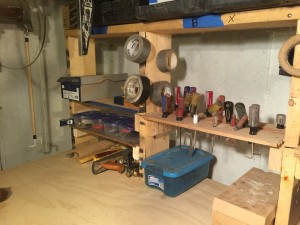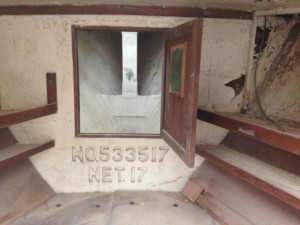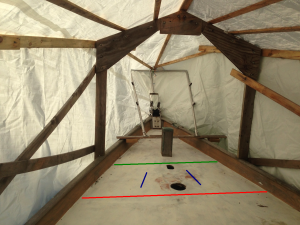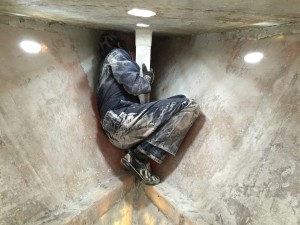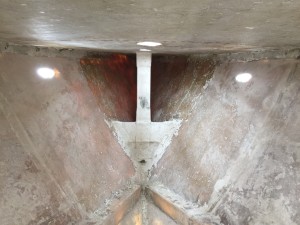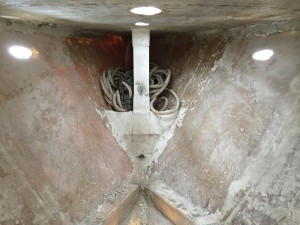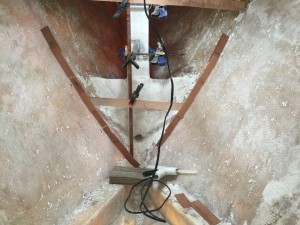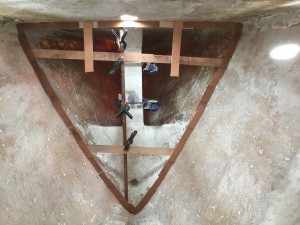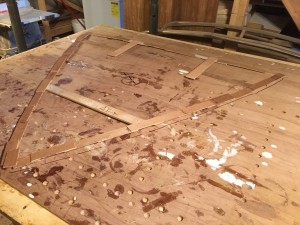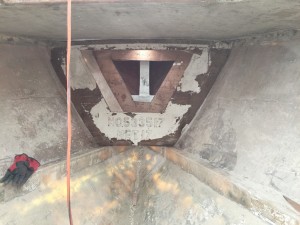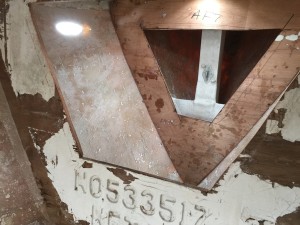3/22/16: Forepeak and Samson post
The 2016-edition of Thalassa’s restoration officially began with a week-long cleaning and organizing of the basement workshop.
On to the boat.
The following photo is from a few years ago, and shows the old bulkhead that separated the forepeak compartment and the forward cabin. The forepeak compartment, whose only purpose was to hold the anchor rode, was 6 feet in length, which is 15% of the overall length of the boat. A very long anchor rode would occupy only a small fraction of that volume, but using that space for general storage is out of the question as additional contents might foul the anchor rode.
The next photo, also from a few years ago, shows the scene from on deck, where the red line shows the approximate position of the old bulkhead. (The green and blue lines will be explained later.) Thalassa’s Samson post (also known as the “bitt”) is a solid piece of teak that extends through and whose bottom end is glassed to a horizontal member that is heavily glassed to the hull. The third paragraph of the March 2010 Practical Sailor contains some history of the Sampson post.
With the forepeak gutted, and the cabin rebuild underway, it is time to consider whether or not some of that unused cabin volume can be reclaimed for practical use or storage. The following photo shows someone scraping old paint from the forepeak area.
Working for about three hours with a heat-gun and scraper produced the following results:
Accessibility is a concern. In the previous photos we can see the outline of the old bulkhead imprinted on the hull, and that it was possible for a person to climb into the forepeak compartment and reach forward, toward stem-fitting bolts and the forward-most toe rail and rub rail bolts. The two holes we see in the topsides are for the navigation lights. The two holes in the deck are for the deck pipe (forward hole, through which the anchor rode passes into the forepeak compartment) and the cowl vent (larger, aft hole).
Three rebuild options have been considered:
(1) No changes: Make a new bulkhead with the same dimensions as the old and install in the original location.
(2) Small changes: Install the new bulkhead about 12″ forward of the original, which would increase the size of the forward cabin and decrease the size of the forepeak compartment. The new forepeak compartment would have about 50% of the volume of the original, but still have more than enough volume. The opening would be designed so that one could reach forward of the Samson post without having the climb all the way into the forepeak compartment. The location of the new bulkhead in this case is forward of the cowl vent, so the hole would be closed and made part of the deck.
The purpose of the cowl vent is to ventilate the forepeak, which, after hauling anchor, will contain a wet anchor rode. The importance of this cowl vent is debatable, as evidenced by the lack of forepeak cowl vents in most pleasure sailboats (e.g., Hinckley Bermuda 40), but a new cowl vent could be installed easily enough.
(3) Major changes: Remove the Samson post and install two new bulkheads–one just aft of the Samson post and one in the location of the original bulkhead. This would create, by far, the smallest forepeak compartment, but there would still be plenty of room for the anchor rode. The following photo shows a 100-foot anchor line with 20 feet of 1/2-inch chain occupying what would be a small fraction of the volume of the new forepeak compartment.
To further explore this possibility, a mockup of the new bulkhead was made using scrap wood. The following photos shows the process.
This template was used to transfer the shape to the scrap wood, and the following photo shows the bulkhead fitted into position. Note that the deck pipe would have to be moved forward so that the anchor rode would fall into the new forepeak compartment. 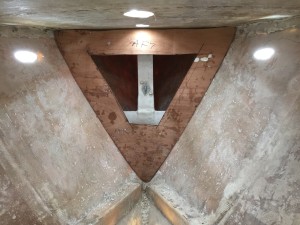
Next, the original bulkhead was hauled back up onto the boat and put back into its original position.
The old bulkhead is 2 feet aft of the new, and the result is a very generous area in which sleeping bags, pillows, and duffel bags might be stowed. The forward bulkhead would have a removable closure. Without the Samson post there would be easy access to once hard-to-reach spaces.
The following photo (displayed previously) shows the location of the new bulkhead (green line) and where substantial deck cleats would be installed (blue lines).
The main disadvantage to this rebuild option is losing the Samson post. Like the forepeak cowl vent, though, Samson posts are quire rare even in classic fiberglass yachts (e.g., Hinckley Bermuda 40). The two bulkheads would make the boat stronger than before, and significantly strengthen the deck in the location of the deck cleats.
No decision has been made.
